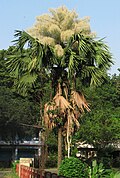Corypha or the gebang palm, buri palmortalipot palm is a genus of palms (family Arecaceae), native to India, Malaysia, Indonesia, the Philippines, New Guinea and northeastern Australia (Cape York Peninsula, Queensland). They are fan palms (subfamily Coryphoideae), and the leaves have a long petiole terminating in a rounded fan of numerous leaflets.
| Corypha | |
|---|---|

| |
| Corypha umbraculifera painting (1913) | |
| Scientific classification | |
| Kingdom: | Plantae |
| Clade: | Tracheophytes |
| Clade: | Angiosperms |
| Clade: | Monocots |
| Clade: | Commelinids |
| Order: | Arecales |
| Family: | Arecaceae |
| Subfamily: | Coryphoideae |
| Tribe: | Corypheae |
| Genus: | Corypha L. |
| Synonyms[1] | |
| |
All are large palms with leaves ranging from 2–5 metres in length. They reach heights of 20–40 m and with a trunk diameter of up to 1-2.5 m. All the species are monocarpic and die after flowering. The genus is relatively slow growing and can take many years to form a trunk.
Species include:[2]
| Flower | Name | Common name | Distribution |
|---|---|---|---|
 |
Corypha lecomtei Becc. ex Lecomte | Thailand, Vietnam, Laos, Cambodia | |
| Corypha microclada Becc. | Philippines | ||
 |
Corypha taliera Roxb. | India: West Bengal, Bangladesh, Myanmar | |
 |
Corypha umbraculifera L. | Talipot palm | Sri Lanka, southern India; naturalized in Thailand, Cambodia, Myanmar, Andaman Islands |
 |
Corypha utan Lam.(syn. C. elata, C. gebang) | Gebang palm, buri palm or cabbage palm | India: Assam, Andaman Islands, Indochina, Malaysia, Indonesia, Philippines, New Guinea, Australia: Queensland, Northern Territory |
In the Philippines, buri trees, like the sago palm, are used as sources of starch made into starch balls called landang. These are traditionally cooked into various desserts and dishes, most notably the binignit.[3]
The leaves are often used for thatching or can be woven into baskets, etc. Three kinds of fibres, namely buri (unopened leaf fibers), raffia (mature leaf fibers), and buntal (leaf petiole fiber), may be obtained from the plant. The midrib of the leaves are also used for weaving hats in the Philippines known as calasiao hats.[4] The Buntal Hat Festival is celebrated in Baliuag, Bulacan yearly every 6th of May.[5][6]